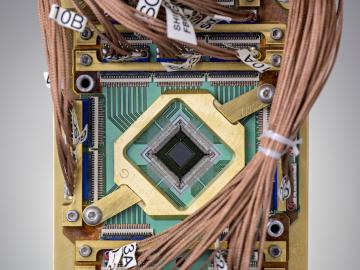
Filter News
Area of Research
- Advanced Manufacturing (1)
- Biological Systems (1)
- Biology and Environment (41)
- Computational Biology (1)
- Computational Engineering (1)
- Computer Science (1)
- Electricity and Smart Grid (1)
- Energy Science (75)
- Fuel Cycle Science and Technology (1)
- Fusion and Fission (30)
- Fusion Energy (5)
- Isotope Development and Production (1)
- Isotopes (10)
- Materials (44)
- Materials for Computing (6)
- National Security (15)
- Neutron Science (25)
- Nuclear Science and Technology (24)
- Supercomputing (81)
News Type
News Topics
- (-) Biomedical (59)
- (-) Energy Storage (75)
- (-) Grid (48)
- (-) High-Performance Computing (113)
- (-) Mercury (9)
- (-) Nuclear Energy (94)
- (-) Space Exploration (16)
- (-) Summit (62)
- 3-D Printing/Advanced Manufacturing (104)
- Advanced Reactors (24)
- Artificial Intelligence (112)
- Big Data (53)
- Bioenergy (93)
- Biology (106)
- Biotechnology (35)
- Buildings (45)
- Chemical Sciences (70)
- Clean Water (18)
- Composites (23)
- Computer Science (174)
- Coronavirus (36)
- Critical Materials (16)
- Cybersecurity (31)
- Education (5)
- Element Discovery (1)
- Emergency (3)
- Environment (154)
- Exascale Computing (64)
- Fossil Energy (7)
- Frontier (60)
- Fusion (54)
- Hydropower (6)
- Isotopes (53)
- ITER (6)
- Machine Learning (50)
- Materials (111)
- Materials Science (111)
- Mathematics (8)
- Microelectronics (4)
- Microscopy (40)
- Molten Salt (5)
- Nanotechnology (46)
- National Security (78)
- Neutron Science (136)
- Partnerships (67)
- Physics (60)
- Polymers (22)
- Quantum Computing (48)
- Quantum Science (79)
- Security (28)
- Simulation (52)
- Software (1)
- Statistics (3)
- Transportation (56)
Media Contacts

Rich Giannone uses bioanalytical mass spectrometry to examine proteins, the primary driver in biological systems.

The Accelerating Therapeutics for Opportunities in Medicine , or ATOM, consortium today announced the U.S. Department of Energy’s Oak Ridge, Argonne and Brookhaven national laboratories are joining the consortium to further develop ATOM’s artificial intelligence, or AI-driven, drug discovery platform.

A rare isotope in high demand for treating cancer is now more available to pharmaceutical companies developing and testing new drugs.

Scientists have found new, unexpected behaviors when SARS-CoV-2 – the virus that causes COVID-19 – encounters drugs known as inhibitors, which bind to certain components of the virus and block its ability to reproduce.

Xin Sun has been selected as the associate laboratory director for the Energy Science and Technology Directorate, or ESTD, at the Department of Energy’s Oak Ridge National Laboratory.

Twenty-seven ORNL researchers Zoomed into 11 middle schools across Tennessee during the annual Engineers Week in February. East Tennessee schools throughout Oak Ridge and Roane, Sevier, Blount and Loudon counties participated, with three West Tennessee schools joining in.

On Feb. 18, the world will be watching as NASA’s Perseverance rover makes its final descent into Jezero Crater on the surface of Mars. Mars 2020 is the first NASA mission that uses plutonium-238 produced at the Department of Energy’s Oak Ridge National Laboratory.

The U.S. Air Force and Oak Ridge National Laboratory launched a new high-performance weather forecasting computer system that will provide a platform for some of the most advanced weather modeling in the world.

A multi-institutional team became the first to generate accurate results from materials science simulations on a quantum computer that can be verified with neutron scattering experiments and other practical techniques.

Thirty-two Oak Ridge National Laboratory employees were named among teams recognized by former DOE Secretary Dan Brouillette with Secretary’s Honor Awards as he completed his term. Four teams received new awards that reflect DOE responses to the coronavirus pandemic.


